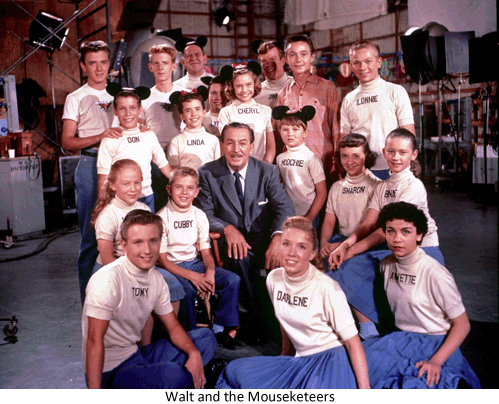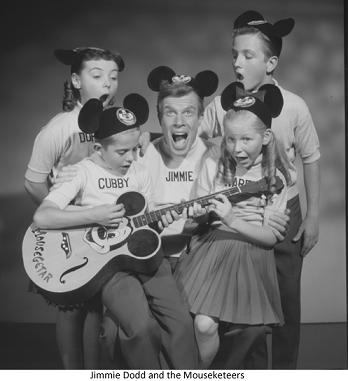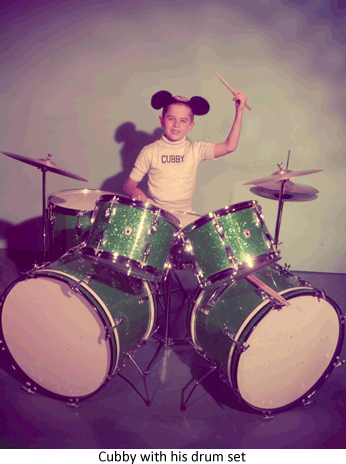Disney historian Paul Anderson, a big Mickey Mouse Club fan, takes us on trip down memory lane:
What immortal words begin, “Who’s the leader of the club?” Of course, every Baby Boomer reading this is now mouthing, or better yet, singing the answer. And now, all together, we can spell (sing) it out: “M-I-C-K-E-Y M-O-U-S-E”. Yes, that famous mouse was the leader of the club! Well, Hey, There; Hi, There; Ho, There. You are correct as you can be (with apologies to Jimmie Dodd) ... but perhaps I can give you a bit of a twist on the question this song asks! Yes, before Mickey became the leader of the club, there was someone else with the job! Albeit, in this case perhaps a more appropriate lyric for what I am suggesting would be “Who’s the innovator of the club?” This would spell out a little differently: “W-A-L-T-E-R D-I-S-N-E-Y!”
 Yes, I am here to make a case that The Mickey Mouse Club is really a bit of a misnomer, and more appropriately should be called The Walt Disney Club, as much of it was his idea, his thoughts, and his vision. And after all, wouldn’t that make him the “leader” of the club? This is all the more believable, when one recounts the many stories about Mickey being Walt’s alter ego ... and visa versa! Maybe it should be called the Walt and Mickey Club? But, I digress.
Yes, I am here to make a case that The Mickey Mouse Club is really a bit of a misnomer, and more appropriately should be called The Walt Disney Club, as much of it was his idea, his thoughts, and his vision. And after all, wouldn’t that make him the “leader” of the club? This is all the more believable, when one recounts the many stories about Mickey being Walt’s alter ego ... and visa versa! Maybe it should be called the Walt and Mickey Club? But, I digress.
So, we’ve all heard how Walt was ahead of his time in so many ways, and honestly, it is sort of an understatement to proclaim him as an innovator or visionary, as he was such in so many different ways. This moniker is especially true in the case of television, where in the 1930s Walt was making such outlandish statements as: “I’m looking to the future, and that includes television.” In fact, he was one of the very few in the film industry to proclaim such heresy; during the Depression his Hollywood neighbors considered TV to be the Big Bad Wolf!
Fast forward two decades, and Walt is off on another one of his visions–a fanciful and magical place where family members of all ages could enjoy themselves by visiting castles, exploring America’s frontier, taking flight in a rocket ship, and cruising down the Congo. Problem was, the bankers were incapable of seeing such a whimsical place as this, as money people were seemingly inflicted with a lack of foresight. So leave it to Walt to use his vision in one area (television) to pay for a vision in another area (Disneyland).
Walt’s first foray into television, One Hour in Wonderland (1950), had been a smashing success! So much so that the television networks were begging him for a regular show. Walt continued to dabble, but television would be on his terms. And those terms were for Disneyland. He needed financing to help him build his happiest place on earth, and television provided him with that little miracle. Walt got his money for Disneyland, and ABC got a weekly anthology show from Walt. And what a show it was; another smashing success! Which brings us back around to the club, the one Walt was the leader of. ABC wanted more programming, and Walt gave them an idea for a show that had been on his mind for a couple of years; it was a daily program done entirely for the youth of America: The Mickey Mouse Club.
 Walt had envisioned the show as specifically aimed at children, which is the first time Disney had done anything “specifically” for children. Yet, even Walt’s concept of doing something just for the youngsters, was drastically different (and improved) from what others were doing “for children.” (There’s that vision thing again!) Walt refused to talk down to children, as was so often done in the entertainment industry. Walt felt that his show–his club if you will–could be childlike, without being childish. He wanted the show to be inclusive to all children and, most importantly, educational. So in 1953, when he first took on the role of a leader (of the club), he scribbled out an outline of what his children’s club might look like. This blueprint now provides us with tremendous insight into Walt’s thoughts and priorities. It is also a prophetic framework for what the club would eventually become. The list included:
Walt had envisioned the show as specifically aimed at children, which is the first time Disney had done anything “specifically” for children. Yet, even Walt’s concept of doing something just for the youngsters, was drastically different (and improved) from what others were doing “for children.” (There’s that vision thing again!) Walt refused to talk down to children, as was so often done in the entertainment industry. Walt felt that his show–his club if you will–could be childlike, without being childish. He wanted the show to be inclusive to all children and, most importantly, educational. So in 1953, when he first took on the role of a leader (of the club), he scribbled out an outline of what his children’s club might look like. This blueprint now provides us with tremendous insight into Walt’s thoughts and priorities. It is also a prophetic framework for what the club would eventually become. The list included:
- Mouse party; audience participation.
- Children selected to be Mickey, Donald, etc. (with costumes) others play the part of Pluto, cat, etc.
- Children from audience visit with characters from history
- Special shows acted by children in Disneyland
- Presents to kids in audience with birthday’s, also unbirthday presents
- Drawing lessons
- Gadget band: kids participate
- Animal acts
- Magician
- Story of children around the world, children in sports (honor Sunday school teachers?)
- Everyone can sing: song slides
Before the show premiered, he explained his philosophy for The Mickey Mouse Club to ABC to a group of advertisers: “I know, of course, that it’s described as a children’s show. Yet there’s something about the expression ‘children’s show’ that I always find disturbing. At our studio, we regard the child as a highly intelligent human being. He is characteristically sensitive, humorous, open-minded, eager to learn, and has a strong sense of excitement, energy and healthy curiosity about the world in which he lives.”
 Obviously with such a vision as this, a major key to the success of the show would be the stars that would populate the club; they would need to be very special kids. The talent round up began with an edict from Walt; first and foremost, he did not want the usual Hollywood cast of kids. He instructed the show’s producer Bill Walsh: “Look around at the local schools for nice-looking kids with good personalities. It doesn’t matter whether they can sing or dance; we’ll teach them at the studio. Watch the kids at recess. You’ll find one who is the center of attention, who is leading all the action. That’s the one we want.”
Obviously with such a vision as this, a major key to the success of the show would be the stars that would populate the club; they would need to be very special kids. The talent round up began with an edict from Walt; first and foremost, he did not want the usual Hollywood cast of kids. He instructed the show’s producer Bill Walsh: “Look around at the local schools for nice-looking kids with good personalities. It doesn’t matter whether they can sing or dance; we’ll teach them at the studio. Watch the kids at recess. You’ll find one who is the center of attention, who is leading all the action. That’s the one we want.”
As the saying goes, the rest is history. Walt and his crew managed to populate his club with some of the very best kids not in the business. That is to say, he got the kind of kids he wanted, a group that fit his philosophy of entertainment. And America responded; it was a smashing success. An unbelievable three-quarters of ALL television sets in service between 5pm and 6pm each weekday were tuned in to Walt’s club! Mouse Ears, the iconic hats for the club, at their peak were selling at a rate of 24,000 a day. Hundreds of manufactured items set off another Disney merchandise craze. And kids between three and twelve were not only singing the song over ... and over ... and over, they were also writing tens of thousands of fan letters each month to the Mouseketeers.
Walt had done his job with the club, and successful as he was, he had other visions and dreams to pursue. The history is unclear, but somewhere along the way, Walt turned over club leadership duties to Mickey Mouse (with the ample help of Roy “Big Mooseketeer” Williams and Jimmie Dodd). The show ran a total of three seasons, before a dispute with ABC abruptly ended the program. The network felt that they could make more money with shows that they owned, rather than purchased from independent producers. Moreover, they had been overloading the show with commercials and then would complain that they could not find enough sponsors for it. Walt hinted at the real reason for the demise of the show; it was greed.
Yet, the legacy of the show is twofold, and carries forth to this day. First, it can be found in the Mouseketeers and how they have lived their lives. The special nature of these people can be found in their memories and stories about working on the show and working with Walt Disney. This Saturday you will have the opportunity to do just that at The Walt Disney Family Museum, as Bobby, Sharon, and Cubby come to share what it was like to be a part of Walt’s club.
The second legacy was to prove Walt right (once again!). That is, his aforementioned philosophy that a child is full of “a strong sense of excitement, energy and healthy curiosity about the world in which he lives.” And that playing to that strength (as compared to “down to” that child), works! Even in the world of television. It makes for better kids, who turn into better adults. And that Walt philosophy quote I used above ... there is more to it! We pick up, where Walt left off: “Lucky indeed is the grownup who manages to carry these same characteristics over into his adult life. It usually makes for a happy and successful individual. Essentially, the real difference between a child and an adult is experience. We conceive it to be our job on ‘The Mickey Mouse Club’ show to provide some of that experience...happy factual, constructive experience, whenever possible. This does not mean to say we are forgetting our chief purpose is entertainment. But we have always tried to be guided by the basic idea that in the discovery of knowledge there is great entertainment–as, conversely, in all good entertainment there is always some grain of wisdom, humanity or enlightenment to be gained.”
Now this is a club I want to belong to! Walt’s Club!
All images courtesy of the Walt Disney Company.
